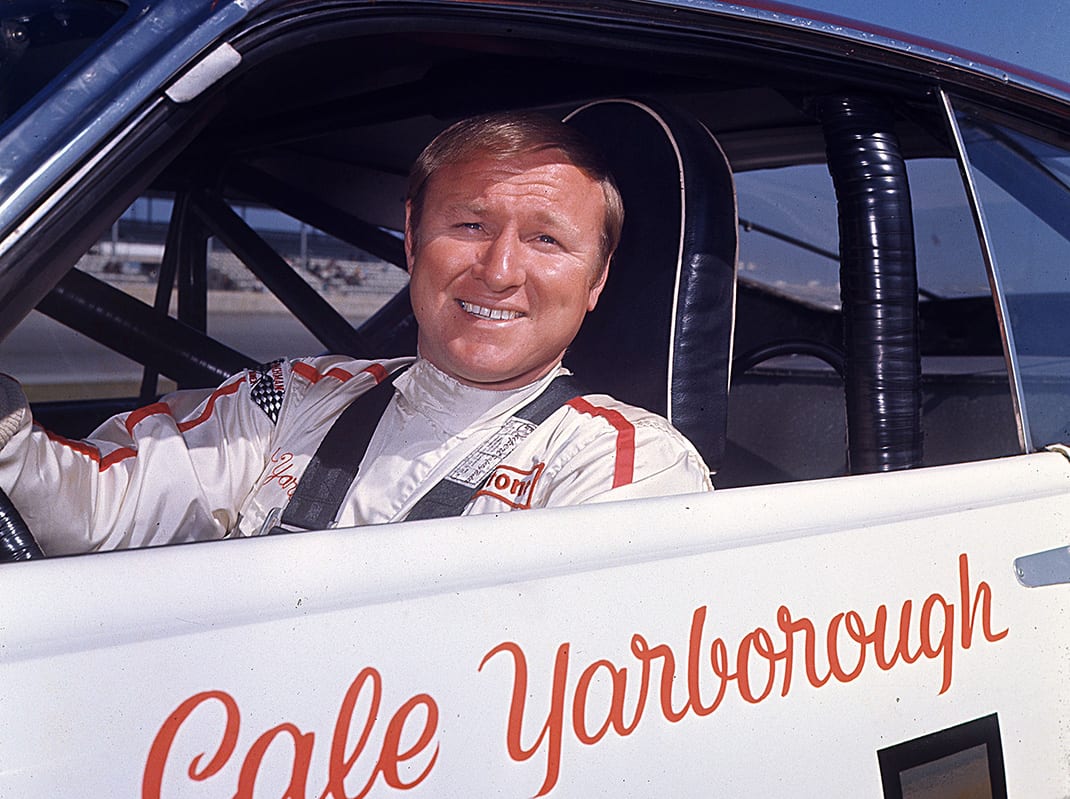Thousands of drivers have entered NASCAR competition since the sanctioning body was formed in 1948. Few, however, have enjoyed the recognition William Caleb “Cale” Yarborough has as one of the toughest and most determined drivers in history.
The three-time NASCAR Cup Series champion, who raced for 31 years, knew only one way to drive — flat out.
The legendary stories of wrestling an alligator, crashing airplanes and being struck by lightning twice are true. His years as a farmer, Golden Gloves boxer and high school and semi-pro football star set the stage for the difficult battles he fought on short tracks and superspeedways. By the time he reached his 40th birthday, Yarborough had won three NASCAR Cup Series championships, having become the first driver in NASCAR history to win three consecutive titles while driving Chevrolets fielded by the legendary Junior Johnson.
Yarborough was a mirror image of Johnson when the former Wilkes County, N.C., moonshiner was in his prime as a NASCAR driver, collecting 50 victories behind the wheel.
“How would I rate those years with Junior?” Yarborough said in Johnson’s book called “Brave in Life.” “You’re asking me to blow my own horn. But they would have run along the top. Yep, they would have run along the top.”
[subscribers_only]
One must take a look into Yarborough’s past to understand the timing of his greatest accomplishment as a race car driver.
Yarborough was born March 27, 1939, the oldest of three boys born to Julian and Annie Yarborough in Sardis, S.C. His family made their living by farming tobacco and cotton and owned and operated a small country grocery store. Upon his father’s death in a private airplane crash in the late 1940s, Yarborough took on the responsibilities of being the breadwinner of the family.
In 1949, Yarborough’s first official foray as a race driver came in a soap box derby car in Darlington, S.C., at age 10. Nearly a decade later, he made his NASCAR debut in the 1957 Southern 500 driving a Pontiac owned by Bob Weatherly. He finished 42nd. He drove for numerous teams before joining the famed Holman Moody Ford operation in 1964.
In 1965, Yarborough scored his first of 83 victories at Valdosta (Ga.) Speedway for team owner Kenny Myler. He drove in select events in 1966 and in ’67 before being hired by Wood Brothers Racing at the start of the 1968 season. He won 13 major superspeedway events during a four-year span for Glen and Leonard Wood.
A completely unexpected turn of events took him out of NASCAR and unknowingly set the stage for his greatest success. Ford Motor Co. withdrew its factory support of NASCAR teams in 1970 as the result of a rules dispute with NASCAR officials. With the future uncertain, Yarborough was released from Wood Brothers Racing.
“I loved NASCAR but I knew I had to do something because I had business obligations and had to make a living, so I needed a ride somewhere,” Yarborough said recently. “It was time to look at all my options and that was when I found a ride outside of NASCAR and stock car racing. I couldn’t sit and wait on something to develop. I had to go out and look for a car to drive.”
Yarborough accepted an offer to drive an Indy car owned by Gene White, running a limited schedule that included the Indianapolis 500. He finished 16th and 10th in two Indy runs in 1971 and ’72.
Open-wheel racing was a different world and Yarborough desperately wanted to get back to NASCAR, the place where he had established his roots. In early January 1973, he received a surprise phone call from team owner Richard Howard with an offer to enter the full 29-race Cup Series season. Bobby Allison had won 10 races with Howard’s team in 1972, but he clashed with team manager Junior Johnson.
“I knew Cale was a determined hard charger,” Johnson said in “Brave in Life.” “Richard (Howard) and I knew that from his connection with Glen Wood. Lee Roy (Yarbrough) had been with us but unfortunately, he got sick. We lost him. Then we had Bobby, and with those two men, we had gotten used to the caliber of driver they were. We didn’t want anything else.
“With us, Cale took the sport to a higher level. It was refreshing to see what we could do without the factory backing. That was perhaps the biggest thing, that we all had to do it on our own — get the sponsors if we could and go out there and race.”
[/subscribers_only]
